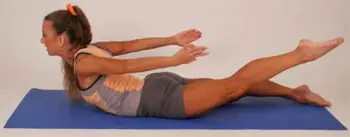Body flexibility - the athlete’s ability to perform exercise movements with a significantly greater amplitude. There are active and passive types of flexibility. Active Flexibility – the physical ability of an athlete to apply a greater range of motion in certain joints of the body by contracting its muscle groups. Passive flexibility - the ability to achieve a significant range of movements by applying additional one’s own efforts or the efforts of a sparring partner.
Content- Exercises to develop body flexibility in the hip joint:
- Exercises to develop body flexibility in the shoulder girdle:
- Recommendations for sports coaches and fitness instructors:
- Contents of the article:
Exercises to develop body flexibility in the hip joint:
- From a standing position on the 1st leg sideways to the support, swing the 2nd leg forward and backward.
- Standing facing the support, perform swings with a slightly bent leg to the right - left side.
- Walking, leaning forward, reaching the floor with your hands at each step.
- Walking with simultaneous lunges forward and cyclic, springy swaying, and then bending forward and reaching the floor with your elbows.
- From a standing position with your back to the wall bar, bend your leg at the knee joint and place the toe of your foot behind the bar. At the same time, bend in the lower back, stretching the pelvis forward.
- Standing on one leg, grab the foot of the other leg with your hand. Bend at the waist and move your leg back. The exercise can be performed in combination with jumping exercises.
- Standing at the gymnastic wall, stretch your feet by moving forward and backward on straight legs: on your toes, then on your heels, rolling and turning your toes in and out.
- With your legs spread wide apart, alternately squat on your right and left legs. Next, in the squat position, move the pelvis to the left and right.
- Standing in a wide stride position - gradually spreading your legs - take a “half-split” or “split” position.
- Standing sideways near the barrier or horse, place your leg bent at the knee on the selected support:
- tilt the body in the direction of the abducted leg;
- bend your torso forward; At the same time, try to touch the knee of the supporting leg with your head.
- Starting position - arms up, fingers intertwined; 1-3 - three jerks; 4 — starting position.
- Starting position - left arm up, right arm pulled back, hands straightened; 1-4 - change hand positions for each count. At the top and bottom, the arms should be pulled back as far as possible.
- Starting position: arms up, palms forward; 1 - maximum rotation of the arms outward, 2 - maximum rotation of the arms inward.
- Starting position - lying down; 1-2 - lower your torso at the shoulder joints as low as possible (do not bend your arms); 3-4 Raise your torso at the shoulder joints as high as possible.
- Initial position - lying horizontally on your back with bent legs, arms forward, palms down, tense your abdominal muscles so that your lower back rests on the floor (not your pelvis and shoulder blades), there should be no gap between your back and the floor; 1-2 - hands up, put them on the floor, 3-4 - return to the original position.
- Starting position - sitting position; 1-2 - support while lying behind, bend over, lifting your torso as high as possible; 3-4 – starting position.
- Starting position - standing vertically with your back to the wall bars, with an overhand grip, grab the bar at shoulder level with your hands, step forward with your left (right) foot, then bend in the thoracic spine.
Cultivating flexibility, undoubtedly, the matter is complex. It requires not only skill from the athlete, but also maximum patience and ingenuity, and from the coach the ability to understand the character of each student. Of great importance is the selection of training tools, their combination in one lesson, a weekly cycle of lessons and in the process of many years of preparation. A certain alternation of training means, their dosage, rest pauses between exercises, special sets of exercises, games in a training session are important factors for revealing the individual inclinations of athletes.
The most effective way to ensure physical fitness is application of exercise setsaimed at the simultaneous development of motor abilities in combination with games and play exercises. Stick to variety in the chosen methodology - do not forget to alternate the emphasis on active, then on passive components of athletes' flexibility.
Classes aimed at developing motor abilities should be conducted lively, emotionally, trying to create a cheerful mood in the students so that performing exercises, especially those aimed at developing flexibility, does not turn into tedious, tiring, routine work.
To maintain interest, it is important to periodically change sets of exercises and outdoor games, gradually moving from easier to more difficult ones. The technique of periodically changing the place of classes also increases their fruitfulness, especially if they are carried out outdoors - in a forest, park, on a sandy slope, in a clearing. And traditional equipment for developing strength abilities is successfully replaced by stones and trees, a treadmill by forest paths with descents and ascents, and a pit with sand by ravines, ditches, fallen trees, as well as jumping on stumps, hillocks, reaching high branches, etc. P.
Contents of the article:
Flexibility and methods of its development.
Active flexibility.
Passive flexibility.
Complex for the hip joint.
Complex for the shoulder girdle.
Flexibility of the body and its education.
Training recommendations.
Post Views: 154


